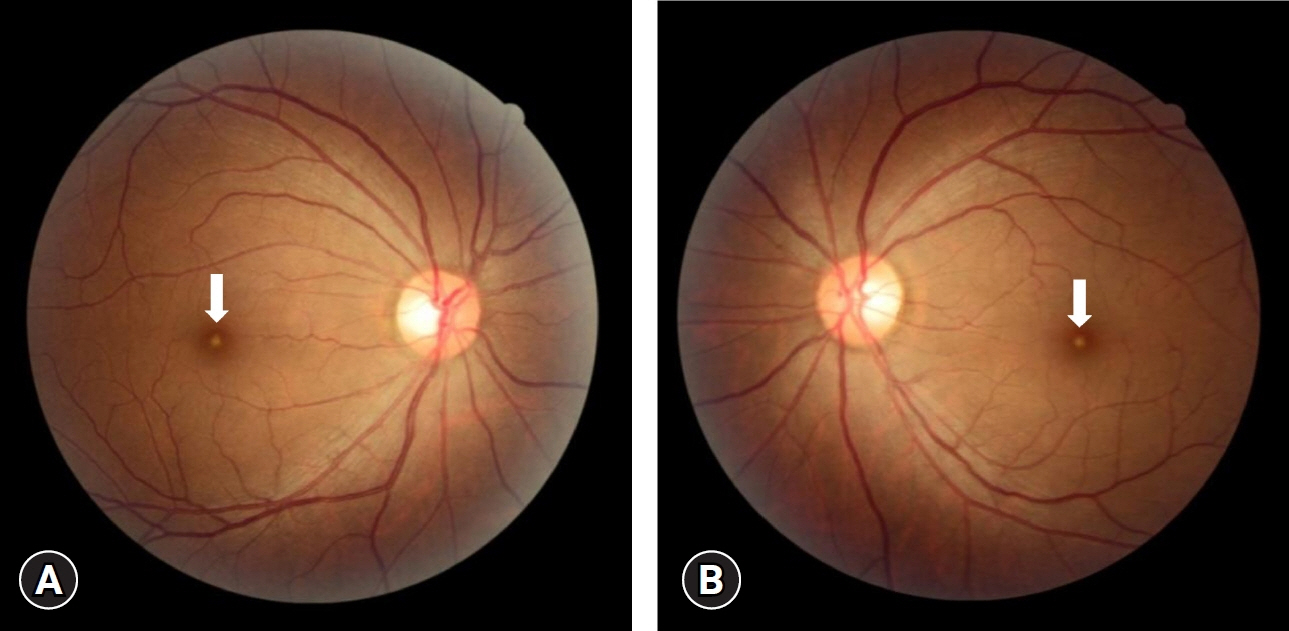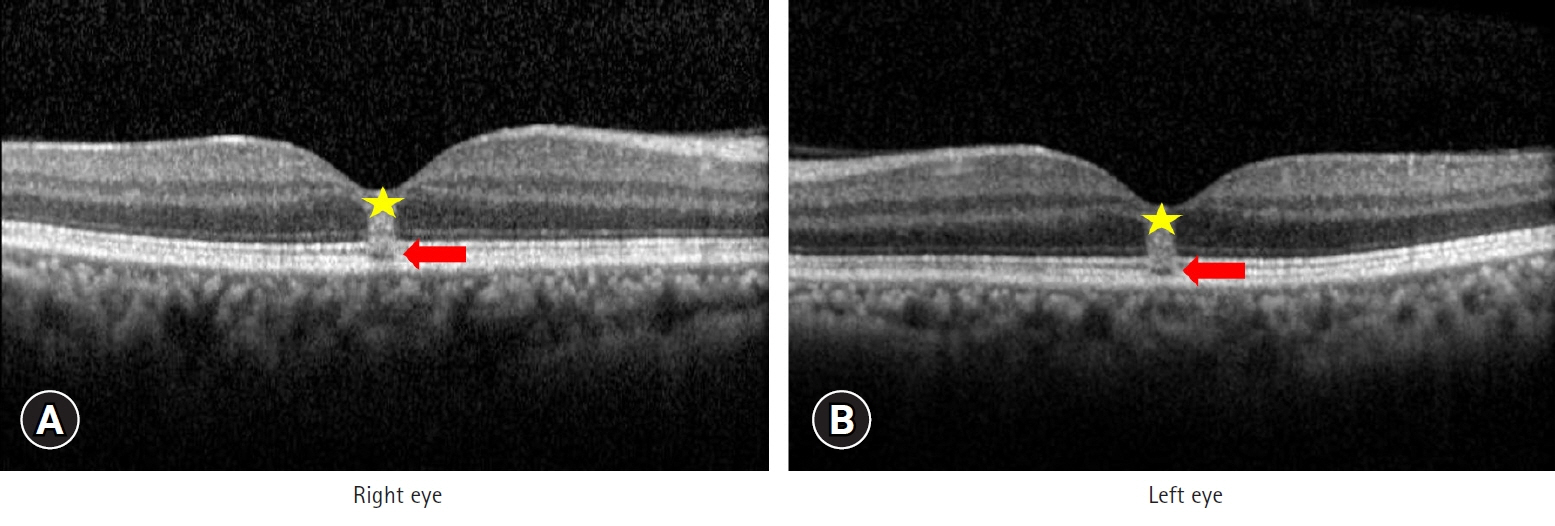J Yeungnam Med Sci.
2024 Jul;41(3):228-232. 10.12701/jyms.2024.00213.
Solar retinopathy related to antidepressant use in a patient with major depressive disorder: a case report
- Affiliations
-
- 1Department of Psychiatry, Yeungnam University College of Medicine, Daegu, Korea
- KMID: 2558148
- DOI: http://doi.org/10.12701/jyms.2024.00213
Abstract
- This case report is a unique case of solar retinopathy following antidepressant-induced mydriasis and highlights the need for comprehensive ophthalmic evaluation in patients treated with medications having mydriatic effects. A 49-year-old female patient who had received long-term antidepressant therapy presented with bilateral visual impairment after prolonged sun exposure. Fundoscopy confirmed solar retinopathy, which was attributed to drug-induced mydriasis. Medication adjustments and sun protection strategies led to full visual recovery, underscoring the importance of interdisciplinary awareness. This case emphasizes the challenges associated with the simultaneous management of psychiatric and ophthalmic conditions and highlights the need for routine ophthalmic evaluation of patients prescribed antidepressants with reported ocular side effects.
Figure
Reference
-
References
1. Richa S, Yazbek JC. Ocular adverse effects of common psychotropic agents: a review. CNS Drugs. 2010; 24:501–26.2. Devadason DS, Mahmood S, Stanga PE, Bishop PN. Solar retinopathy in a patient with bipolar affective disorder. Br J Ophthalmol. 2006; 90:247.3. Anaclerio AM, Wicker HS. Self-induced solar retinopathy by patients in a psychiatric hospital. Am J Ophthalmol. 1970; 69:731–6.4. Schatz H, Mendelblatt F. Solar retinopathy from sun-gazing under the influence of LSD. Br J Ophthalmol. 1973; 57:270–3.5. Bechmann M, Ehrt O, Thiel MJ, Kristin N, Ulbig MW, Kampik A. Optical coherence tomography findings in early solar retinopathy. Br J Ophthalmol. 2000; 84:547–8.6. Davies S, Elliott MH, Floor E, Truscott TG, Zareba M, Sarna T, et al. Photocytotoxicity of lipofuscin in human retinal pigment epithelial cells. Free Radic Biol Med. 2001; 31:256–65.7. Jain A, Desai RU, Charalel RA, Quiram P, Yannuzzi L, Sarraf D. Solar retinopathy: comparison of optical coherence tomography (OCT) and fluorescein angiography (FA). Retina. 2009; 29:1340–5.8. Tso MO, La Piana FG. The human fovea after sungazing. Trans Sect Ophthalmol Am Acad Ophthalmol Otolaryngol. 1975; 79:OP788–95.9. Hope-Ross MW, Mahon GJ, Gardiner TA, Archer DB. Ultrastructural findings in solar retinopathy. Eye (Lond). 1993; 7(Pt 1):29–33.10. Saletu B, Grünberger J. Drug profiling by computed electroencephalography and brain maps, with special consideration of sertraline and its psychometric effects. J Clin Psychiatry. 1988; 49(Suppl):59–71.11. Deijen JB, Loriaux SM, Orlebeke JF, de Vries J. Effects of paroxetine and maprotiline on mood, perceptual-motor skills and eye movements in healthy volunteers. J Psychopharmacol. 1989; 3:149–55.12. Ramaekers JG, Muntjewerff ND, O’Hanlon JF. A comparative study of acute and subchronic effects of dothiepin, fluoxetine and placebo on psychomotor and actual driving performance. Br J Clin Pharmacol. 1995; 39:397–404.13. Schmitt JA, Riedel WJ, Vuurman EF, Kruizinga M, Ramaekers JG. Modulation of the critical flicker fusion effects of serotonin reuptake inhibitors by concomitant pupillary changes. Psychopharmacology (Berl). 2002; 160:381–6.14. Malone DA Jr, Camara EG, Krug JH Jr. Ophthalmologic effects of psychotropic medications. Psychosomatics. 1992; 33:271–7.15. Narurkar V, Smoller BR, Hu CH, Bauer EA. Desipramine-induced blue-gray photosensitive pigmentation. Arch Dermatol. 1993; 129:474–6.16. Ming ME, Bhawan J, Stefanato CM, McCalmont TH, Cohen LM. Imipramine-induced hyperpigmentation: four cases and a review of the literature. J Am Acad Dermatol. 1999; 40(2 Pt 1):159–66.17. Taniguchi S, Hamada T. Photosensitivity and thrombocytopenia due to amitriptyline. Am J Hematol. 1996; 53:49–50.18. Ljunggren B, Bojs G. A case of photosensitivity and contact allergy to systemic tricyclic drugs, with unusual features. Contact Dermatitis. 1991; 24:259–65.19. Constable PA, Al-Dasooqi D, Bruce R, Prem-Senthil M. A review of ocular complications associated with medications used for anxiety, depression, and stress. Clin Optom (Auckl). 2022; 14:13–25.20. Bouattour N, Bouattour W, Messedi N, Charfeddine F, Aribi L, Aloulou J. Mydriasis caused by ESCITALOPRAM: case report. Eur Psychiatry. 2022; 65(Suppl 1):S727–8.
- Full Text Links
- Actions
-
Cited
- CITED
-
- Close
- Share
- Similar articles
-
- A Case of Solar Retinopathy
- A Case of Restless Leg Syndrome Induced by Mirtazapine in a Patient with Major Depressive Disorder
- The Effects of Cognitive Therapy in Major Depressive Disorder
- Current Update on Transcranial Direct Current Stimulation as Treatment for Major Depressive Disorder
- Selection of an Antidepressant Based on the Genotypes of Cytochrome P450 Enzymes Genes in a Patient with Major Depressive Disorder



